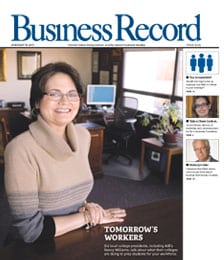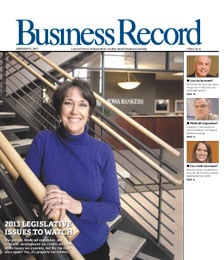Interest increasing in interest-only mortgages

You’d have to revisit the pre-Depression 1920s to find a time when interest-only mortgages were as popular as they are today among U.S. home buyers.
Already red-hot in overheated housing markets such as California, Texas and Florida, interest-only mortgages are becoming more popular with lenders and borrowers alike in Central Iowa, despite the inherent risks. Well-suited to affluent borrowers financing second homes, or executives and salespeople who have bonus or commission income to pay off principal balances, the loans are also being offered to first-time home buyers in Des Moines.
“We find that those (customers with the best credit) have been most interested in the product,” said Tracy Frette, mortgage banking manager for Liberty Bank in West Des Moines, “but we’ve also had quite a few first-time home buyers who have been enticed by the lower payments that they see being advertised. And those first-time home buyers have been qualifying.”
Interest-only payment provisions, usually offered as an option with adjustable-rate loans, allow borrowers to choose to pay only the interest portion of their loans for three, five, seven or 10 years before repayment of the principal begins.
A borrower taking out a $275,000 loan, for instance, could lower his or her payment by $265 a month by using a five-year adjustable-rate, interest-only mortgage compared with a regular five-year ARM, according to Bankrate.com.
Four years ago, interest-only loans accounted for less than 2 percent of loans, but on average now account for about 22 percent of all new loan originations, according to a survey of major metropolitan areas recently published by BusinessWeek Online.
According to the survey, conducted by LoanPerformance, a San Francisco-based real estate information service, San Diego topped the market last year for interest-only loans, with nearly 48 percent of all mortgage loans being in that category. In the Midwest, 24 percent of loans in the Minneapolis-St. Paul market were interest-only, while in Kansas City nearly 10 percent of loans were interest-only in 2004.
Regulators are watching the trend carefully. Last month, several financial regulators, including the Federal Reserve Board and the Office of the Comptroller of the Currency, issued guidelines to financial institutions that cautioned them to consider reviewing their underwriting standards for such loans.
Frette said she has originated about a dozen interest-only loans within the past six months, for customers varying from buyers of a second home in Florida to first-time home buyers in Des Moines.
“There are definite benefits and definite risks involved,” she said. “The things I tell my customers, especially first-time home buyers, are (that there are) risks involved in not paying your principal on your loan, particularly if you’re going to be in that home for a period of time. They need to be aware that their home may not appreciate to the point that they would be able to sell their home and come out ahead or at least even.”
Dan Vessely, president of Iowa Bankers Mortgage Corp., a for-profit arm of the Iowa Bankers Association that provides mortgage services to banks throughout the state, said his organization has chosen not to offer interest-only loans.
“I think they become a problem,” Vessely said. “In my opinion, what has happened is that they were intended for high-income professionals who are in a tax situation where it makes sense for them, or young professionals who expect their income to go up quite a bit. But I think what’s happened is that they’ve turned into a product to get into more house than (buyers) can afford, and I think that’s the potential risk in them.”
Rather than offer interest-only loans, Iowa Bankers Mortgage last month introduced a 40-year mortgage, a product that appears poised to become more popular since Fannie Mae and Freddie Mac have begun buying such loans from banks.
“We feel that’s an appropriate alternative that can lower someone’s payments, yet still be making progress toward paying down the debt,” he said.
Though interest-only loans aren’t for everyone, they’re clearly an instance of the market responding to customers’ demands, said Kurt Kuta, Liberty Bank’s president.
“The financial market is always evolving, whether it’s the result of a lot of people trying to afford homes in very expensive housing markets, or just the result that rates went up from historical lows two years ago. This is allowing people to get into a home at the same rate they could have in 2003.”
A representative of another lender, Wells Fargo Home Mortgage, said his company has built in a series of choices its customers can make that help mitigate the potential risks.
“We allow them to choose when the loan begins amortizing,” said Joe Rogers, an executive vice president at Wells Fargo Home Mortgage’s Columbia, Md., office. “It can begin at the end of the (adjustable rate) period, or at the end of the 10th year. That gives the borrower a lot more time to think about what they want to do, so they can absorb that change over a longer period of time.
“On the very-short-term ARMs, we tell them if they choose to have it start amortizing after three or five years, the rate we would qualify them at would be about 2 percent higher to give them a cushion (to ensure they would have no difficulty paying the higher amortizing payment),” he said.
Interest-only loans are just one of many options for borrowers to consider, Rogers said. And as some other lenders are doing, Wells Fargo will automatically recast the loan’s amortization schedule the month following an optional principal payment, which will result in a lower payment. “That’s an aspect I think is very cool,” he said.







